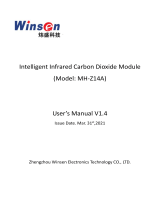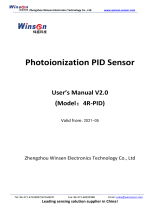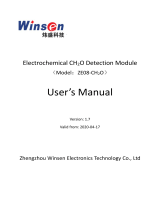Zhengzhou Winsen Electronics Technology Co., Ltd www.winsen-sensor.com
especially brine, or be exposed to halogen such as fluorine.
1.4 Touch water
Sensitivity of the sensors will be reduced when spattered or dipped in water.
1.5 Freezing
Do avoid icing on sensor’s surface, otherwise sensing material will be broken and lost sensitivity.
1.6 Applied higher voltage
Applied voltage on sensor should not be higher than stipulated value, even if the sensor is not
physically damaged or broken, it causes down-line or heater damaged, and bring on sensors’ sensitivity
characteristic changed badly.
2 .Following conditions must be avoided
2.1 Water Condensation
Indoor conditions, slight water condensation will influence sensors’ performance lightly. However, if
water condensation on sensors surface and keep a certain period, sensors’ sensitive will be decreased.
2.2 Used in high gas concentration
No matter the sensor is electrified or not, if it is placed in high gas concentration for long time, sensors
characteristic will be affected. If lighter gas sprays the sensor, it will cause extremely damage.
2.3 Long time storage
The sensors resistance will drift reversibly if it’s stored for long time without electrify, this drift is
related with storage conditions. Sensors should be stored in airproof bag without volatile silicon
compound. For the sensors with long time storage but no electrify, they need long galvanical aging
time for stability before using. The suggested aging time is 24 hours at least if the storage time is more
than half a year.
2.4 Long time exposed to adverse environment
No matter the sensors electrified or not, if exposed to adverse environment for long time, such as high
humidity, high temperature, or high pollution etc., it will influence the sensors’ performance badly.
2.5 Vibration
Continual vibration will result in sensors down-lead response then break. In transportation or
assembling line, pneumatic screwdriver/ultrasonic welding machine can lead this vibration.
2.6 Concussion
If sensors meet strong concussion, it may lead its lead wire disconnected.
3.Usage suggestions
3.1 Pins connection
When the sensor is connecting to the circuit, one of detection part pins and one of compensation part
pins connects as the signal output. The other pin of detection part connects negative electrode, while the
other pin of compensation part connects positive electrode. The part with “D” mark on the sensor bottom
is the detection one, the other part with “C” mark is the compensation one.
3.2 Soldering
For sensor, handmade welding is optimal way. The welding conditions as follow:
Soldering flux: Rosin soldering flux contains least chlorine
Homothermal soldering iron
Temperature: <350℃
Time:less than 5 seconds
If disobey the above using terms, sensors performance will get worse.









